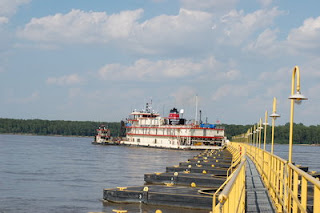On family records acquired from other Bourgoyne researchers, Julia Ferbos, my husband's paternal great-grandmother, was listed as Julia Loubiere. As I began researching her ancestry, I uncovered errors made in Julia's written history and found the truth behind the confusion surrounding her surname. The mistaken identity of Julia's surname was created by the assumption that Julia's father was Gerald "Gabriel" Loubiere, who was married to Julia's biological mother, Pamelia Marson. As my research progressed, I discovered that Gerald Loubiere was Pamelia's second husband. Pamelia Marson married Gerald Loubiere on 26 November 1860. Since this marriage occurred after Julia's birth, 24 January 1856, I questioned the surname Loubiere in reference to Julia. Thus began my quest to find Julia's biological father through a search of census records and other available online resources.
Further research into marriage records from St. John the Baptist Church in Brusly, Louisiana revealed that Julia's mother, Pamelia Marson, married Paul Alfred Ferbos on 19 April 1852. A look into the 1860 census of Brusly Landing in West Baton Rouge Parish shows "Wd. Paul Ferbos", female, age 28, was head of household with two children- Marie C. Ferbos, age 6, and Julie A. Ferbos, age 4. For me, this was the link that connected Julia to her biological father.
The 1870 census in West Baton Rouge Parish, Louisiana shows "Mrs. Gab Loubiere", age 41, as head of household with the following minor children- Clara Furbois, age 15, Julie Furbois, age 14, Davis Loubiere, age 7, Agloe? Loubiere, age 6, Abel Loubiere, age 4, and Felici Loubiere, age 2. "Gabrael Loubiere", age 56, was listed in the Joseph Thomas household, next door. I am a little curious about that situation- were Pamelia and Gab separated or divorced at that time?
By 1880, Julia Ferbos, still single in her early 20's, was listed in the household of her cousins, J.E. and Annette Babin, of Brush Landing in West Baton Rouge Parish. Her sister, Marie Clara Ferbos, had married in 1871 to Louis Octave Dupuy. Julia's mother, Pamelia, was then listed as widowed and resided in the 1st Ward of West Baton Rouge Parish, along with her children "Abell", "Phyillis" and "Lelia". Marie Clara and her family lived next door to Pamelia.
Julia married Samuel M. Smith, the son of William Smith and Adelaide Covington, about 1883-1884. I do not yet have documentation of their marriage date. Samuel was born in September 1852 and his family was from Kentucky. The 1900 census of Police Jury Ward 1, West Baton Rouge Parish shows Samuel M. Smith, age 47, as head of household and he and his wife, Julia, age 46, had been married 15 years. They were parents of 9 children born, of whom 7 children were still living- daughter Annie, age 15, daughter Mable, age 13, son Alphonse, age 12, daughter Lillie, age 10, daughter Dora, age 9, son Farrice, age 6 and son Norton, age 4.
Ten years later Julia was listed as widowed on the 1910 census. She resided in the same location (see Sardine Point Residential Illustration, Mrs Julie Smith Estate, Lot #25B
here) and headed her household with children Alphonse, Lillie, Ferris and Norton. She and daughter Lillie worked in their home while the young men tended to the farm. Julia's half brother, Abel Loubiere and his wife lived next door.
In 1920, Julia still resided in the same location on Sardine Point in West Baton Rouge Parish. By then, Julia was 64 years old and remained widowed. Most of her children had moved on, except for the two younger sons who remained with her- Ferris and Norton. Ferris, who was then listed as 27 years old and still single, worked as a carpenter on one of the plantations while his brother Norton, a 24 year old single man, worked as a butcher. Abel Loubiere and his wife still resided next door to Julia and her family.
Julia Ferbos Smith died on Valentines Day, 14 February 1928 in West Baton Rouge Parish, Louisiana. At the present time, I'm unaware of where she or her husband Samuel are buried. I hope to someday locate their grave site so I can "visit".
In summary, the children of Julia Ferbos and Samuel M. Smith were:
i. Annie Bell Smith, born 31 August 1884, married Delma White
ii. Mable Mary Smith, born 14 July 1887 and died 17 August 1954, married Gillie Joseph Breaux
iii. Alphonse William Smith, born May 1888, married Arcelle Fryoux
iv. Geneieve Lillie Smith, born 09 February 1890 and died 04 January 1932, married Henry Joseph Bourgoyne
v. Dora Smith, born April 1891 and died 23 February 1920, married Stephen Fryoux
vi. Ferris Morris Smith, born 26 July 1893 and died 24 February 1942
vii. Norton William Smith, born 11 August 1895 and died 15 July 1968, married Bertha Thompson








.jpg)
.jpg)
.jpg)


.jpg)
.jpg)
.jpg)
.jpg)
.jpg)

.jpg)
.jpg)





.jpg)
.jpg)
.jpg)
.jpg)
.jpg)







